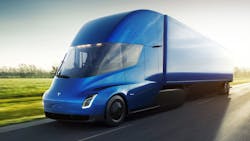Ready or not, zero-emission trucks are the future
Zero emissions, or ZE, is an easy concept to understand. It describes a vehicle with a propulsion system that emits nothing from a tailpipe. No particulate matter, no nitrogen oxide, no carbon dioxide—nothing adding to air pollution or global warming gases. It’s a precise definition, at least in theory.
When it comes to ZE vehicles, though, the reality is far cloudier. One way or another, ZE is going to be part of trucking’s future, as regulatory and social pressures mount around the world to eliminate mobile sources of greenhouse gases and air-borne health hazards.
But this is still just the early days of ZE vehicle development. With the growing likelihood that trucks are going to be pushed into the vanguard of mobile ZE applications, it’s time to take a close look at what’s quickly gone from simple concept to a far more nuanced subject.
What started as a rich person’s fad with Tesla and other electric cars is now being asked to take on a utilitarian role where reliability, practicality and cost rule. Is ZE technology ready to stand up to those demands? Will ZE trucks radically change the industry’s basic equipment, or will it become a good fit only for carefully chosen niche applications?
And what about alternative truck technologies that deliver what’s sometimes called near-zero emissions? Are they part of a long-term solution, or just a bridge until ZE systems become cost-effective and practical?
Since the entire discussion revolves around vehicle emissions, we need to start with some basic definitions. Diesel engines, which power almost all medium- and heavy-duty trucks, produce two categories of emissions: those that affect ambient air quality and those that contribute to global warming.
The important air quality emissions are particulate matter (PM) and oxides of nitrogen (NOx), which in large concentrations like those found in many urban areas pose serious health risks. Carbon emissions from vehicles in the form of carbon dioxide (CO2) are one of the principal greenhouse gases (GHGs) implicated in damaging the Earth’s ozone layer and causing a steady increase in global temperature predicted to bring catastrophic environmental changes.
For the past 25 years, federal emissions standards focused on improving ambient air quality with a series of stepped reductions in PM and NOx that reached its final stage in 2010. Or final at least for now. The PM and reductions to ultra-low 2010 standards required diesel engine aftertreatment systems with high costs and complexity, as well as removing sulfur from diesel fuel.
With ambient air emissions addressed, the U.S. Environmental Protection Agency (EPA) turned its attention to GHG, calling for an overall 20% reduction in heavy-truck CO2 emissions between 2014 and 2018. For diesels and any other internal combustion engines, CO2 is directly related to fuel consumed, so in effect EPA mandated that trucks become more fuel efficient. Improved fuel controls and combustion efficiency along with aerodynamic aids have delivered the required fuel efficiency gains.
Which brings us to 2019. Ultra-low ambient air emissions and a 20% reduction in CO2 for trucks are milestone achievements, but large urban areas like southern California are still struggling to meet clean air standards, and concern over global warming is only increasing pressure to escalate carbon reductions. Prodded by regional regulatory bodies like the California Air Resources Board (CARB), EPA responded in 2016 by proposing what it is calling Phase 2 of its GHG regulations. Starting in 2021, it would require heavy-duty tractors to cut CO2 tailpipe emissions by another 24% by 2027 and vocational HD trucks to drop CO2 production by 16%.
The focus on PM and NOx has not gone away either. With CARB leading the way in calling for even lower ambient air tailpipe emissions, late last year EPA released a proposed “Cleaner Truck Initiative” that would cut diesel NOx from its current 0.2 g/bhp-hr. level to 0.02. Details on a timetable for the reduction aren’t expected until 2020, when EPA says it plans to issue a final rule.
Despite deep reductions in diesel tailpipe emissions, trucks are still identified as a major source of both ambient air and GHG emissions. And that is the impetus behind growing calls for ZE trucks, calls that range from cautious proposals to fund pilot projects to those that want to spark a rapid and nearly total conversion of all commercial vehicles.
This week on FleetOwner.com, we’ll take a deeper look at the future of ZE truck technologies in this series. Read Part 2 and Part 3.
About the Author
Jim Mele
Jim Mele is a former longtime editor-in-chief of FleetOwner. He joined the magazine in 1986 and served as chief editor from 1999 to 2017.
